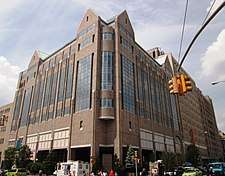Morgan Stanley Children's Hospital
| Morgan Stanley Children's Hospital | |
|---|---|
| NewYork–Presbyterian Hospital | |
|
| |
 2014 | |
| Geography | |
| Location | New York City, New York, United States |
| Coordinates | 40°50′23″N 73°56′28″W / 40.8397°N 73.9412°WCoordinates: 40°50′23″N 73°56′28″W / 40.8397°N 73.9412°W |
| Organization | |
| Hospital type | Teaching hospital |
| Affiliated university | Columbia University |
| Services | |
| Emergency department | Level I pediatric[1] |
| History | |
| Founded |
1887 (Babies' Hospital) 2003 (current building) |
Morgan Stanley Children's Hospital of New York-Presbyterian (CHONY[2]) is the only pediatric hospital in New York City. Located at 3939 Broadway at West 165th Street in the Washington Heights neighborhood of Manhattan, New York City, it is a part of New York-Presbyterian Hospital and the Columbia University Medical Center. The hospital has a dedicated pediatric emergency department and is named after financial firm Morgan Stanley, which largely funded its construction through philanthropy.
History
Although the hospital traces its roots to the establishment of Columbia University's – then King's College – Department of Pediatrics in 1767, it was officially founded as Babies' Hospital in 1887. At the time of its opening, New York City's hospitals only had 25 beds catering to infants and children.[3] In 1929 the hospital moved from its Lexington Avenue site to Upper Manhattan to become part of the Columbia–Presbyterian Medical Center.[4] It remains affiliated with the Columbia University College of Physicians and Surgeons ("P&S") and many of its physicians are at faculty members of the P&S.
In 2010, Morgan Stanley Children's Hospital was the only children's hospital in New York City to be named an Honor Roll hospital by U.S. News and World Report. In 2012/13, it no longer appeared on the Honor Roll,[5] but as of 2016 it is still ranked #13 in pediatric cardiology heart surgery.[6]
The hospital is named after financial firm Morgan Stanley in recognition of the firm's sponsorship of the hospital[7] started under CEO Philip J. Purcell and completed under John Mack. Employees at the firm have been involved with the hospital since the 1990s and personally donated to the construction of the current child-friendly building, which opened in November 2003.[8][9]
Milestones
Physicians from the Morgan Stanley Children's Hospital were the first to identify the difference between celiac disease and cystic fibrosis, and to develop the sweat test for cystic fibrosis. Other achievements include the first description of persistent fetal circulation syndrome, the development of continuous positive alveolar pressure (CPAP) as a treatment for premature infants, the creation of the Apgar score and the performance of the world's first pediatric heart transplant.[10]
See also
References
- ↑ "New York State Trauma Centers". New York State Department of Health.
- ↑ Columbia-Presbyterian General Surgery Applicant Page. Vesta.cumc.columbia.edu. Retrieved on 2013-09-07.
- ↑ Tom Miller (March 2016),The 1902 Babies' Hospital
- ↑ "Babies Hospital History: A Long Tradition of Caring Continues into the 21st Century". Columbia University Medical Center. October 27, 2003.
- ↑ Best Children’s Hospitals 2012–13: The Honor Roll – US News and World Report. Health.usnews.com (2012-06-05). Retrieved on 2013-09-07.
- ↑ "New York-Presbyterian Morgan Stanley-Komansky Children's Hospital in New York, NY". US News Best Hospitals. Retrieved 2016-09-04.
- ↑ "Morgan Stanley 2005 Charitable Annual Report" (PDF). Archived from the original (PDF) on 2007-03-09. Retrieved 2007-05-05.
- ↑ "At Children's Hospitals, Friendly Designs". The New York Times. November 17, 2002.
- ↑ "New York City Opens One of the Largest Children's Hospitals in the Country". NewYork–Presbyterian Hospital. November 12, 2003.
- ↑ "Babies Hospital's Name Changes". P&S Journal. Columbia University Medical Center. 14 (2). Spring 1994.
External links
- Official website
- Architectural essay on the original building at 55th Street and Lexington Avenue.
.png)